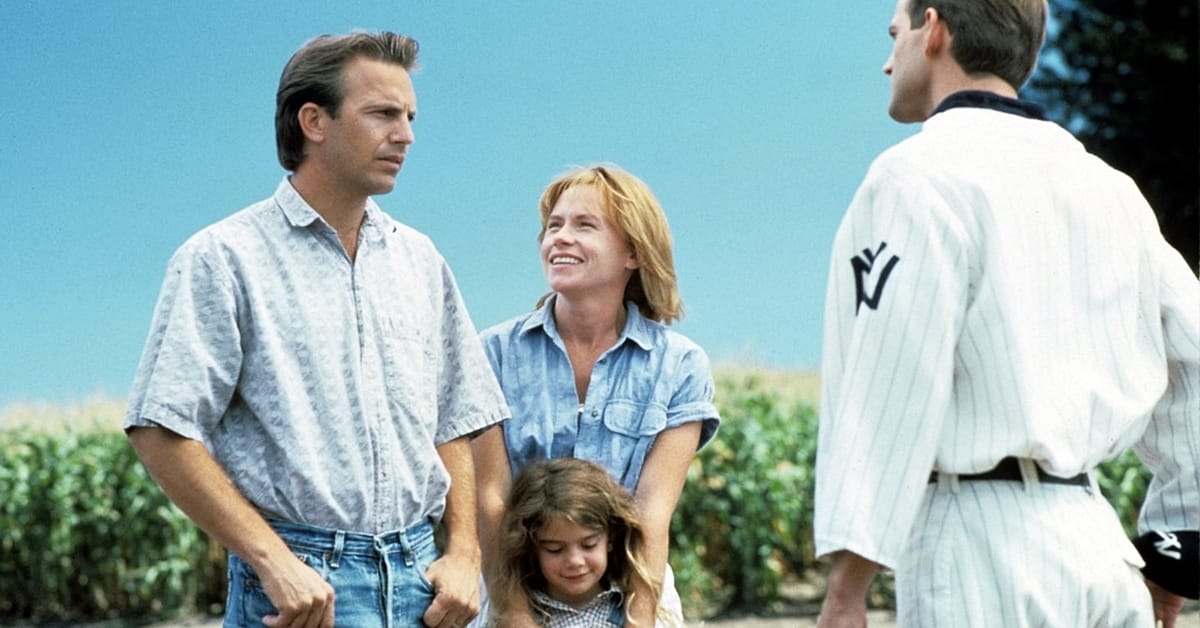“If you build it, he will come,” is what a voice tells an Iowa corn farmer in Field of Dreams, prompting him to build a baseball field on his land.
With a charismatic performance from Kevin Costner, this unique blend of supernatural fantasy and sports drama is one of the most heartwarming films of the 80s. Here are some fascinating facts about Field of Dreams which you might not have known.
25. It’s adapted from a novel, which was based on the true story of Shoeless Joe Jackson
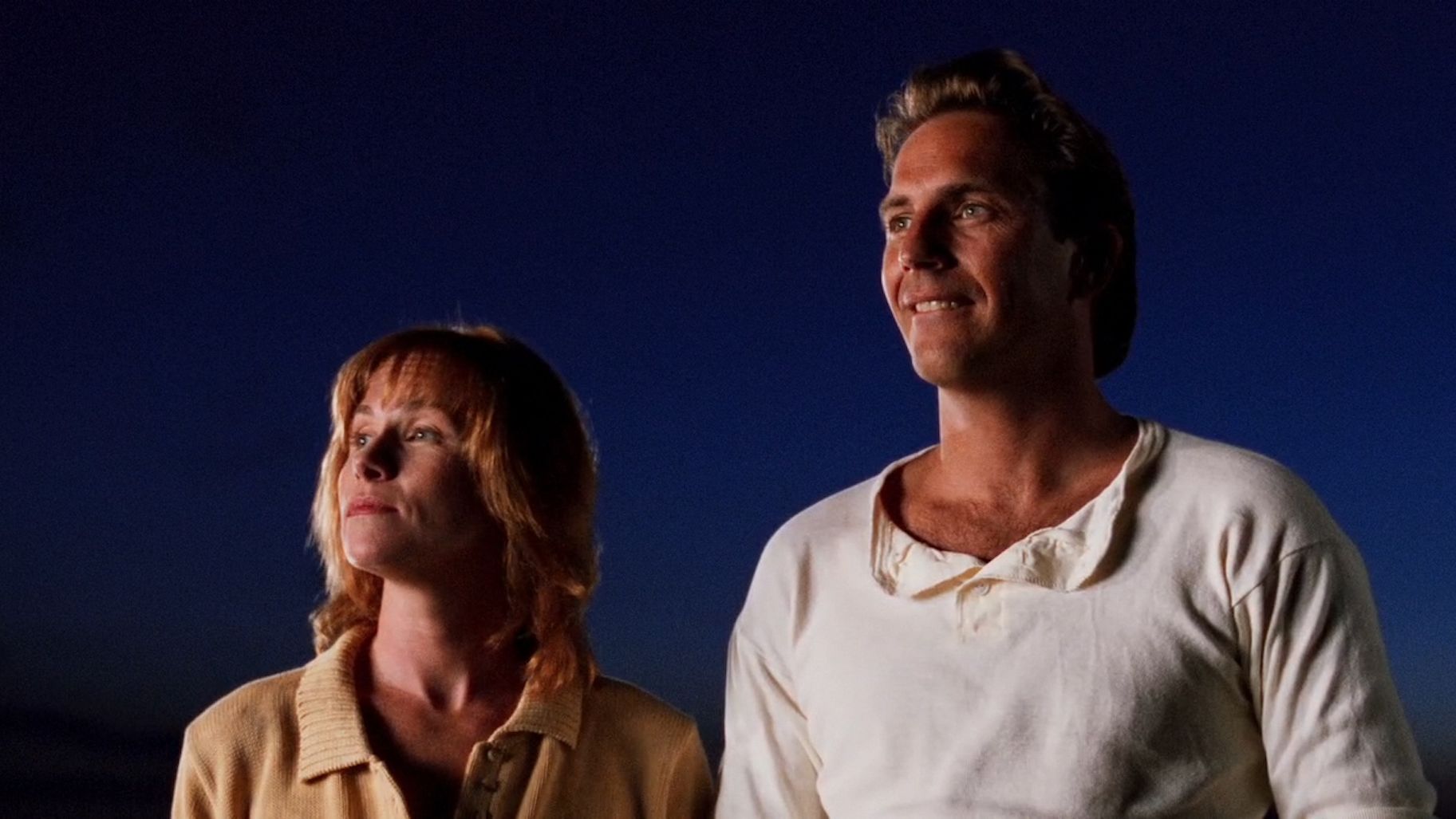
Field of Dreams is based on Canadian author W.P. Kinsella’s 1982 novel Shoeless Joe, which was itself inspired by the true story of Chicago White Sox outfielder ‘Shoeless’ Joe Jackson, who died in 1951. The movie adaptation almost took the name of the book, but test audiences disapproved, claiming it sounded like a movie about a ‘hobo’.
Director/screenwriter Phil Alden Robinson was at first unhappy that studio Universal renamed the film Field of Dreams, and expected novelist Kinsella to be similarly disappointed. Happily, Kinsella loved the title, noting that at one point he had considered calling his original novel Dream Field.
24. Terence Mann is a fictionalised take on novelist J.D. Salinger
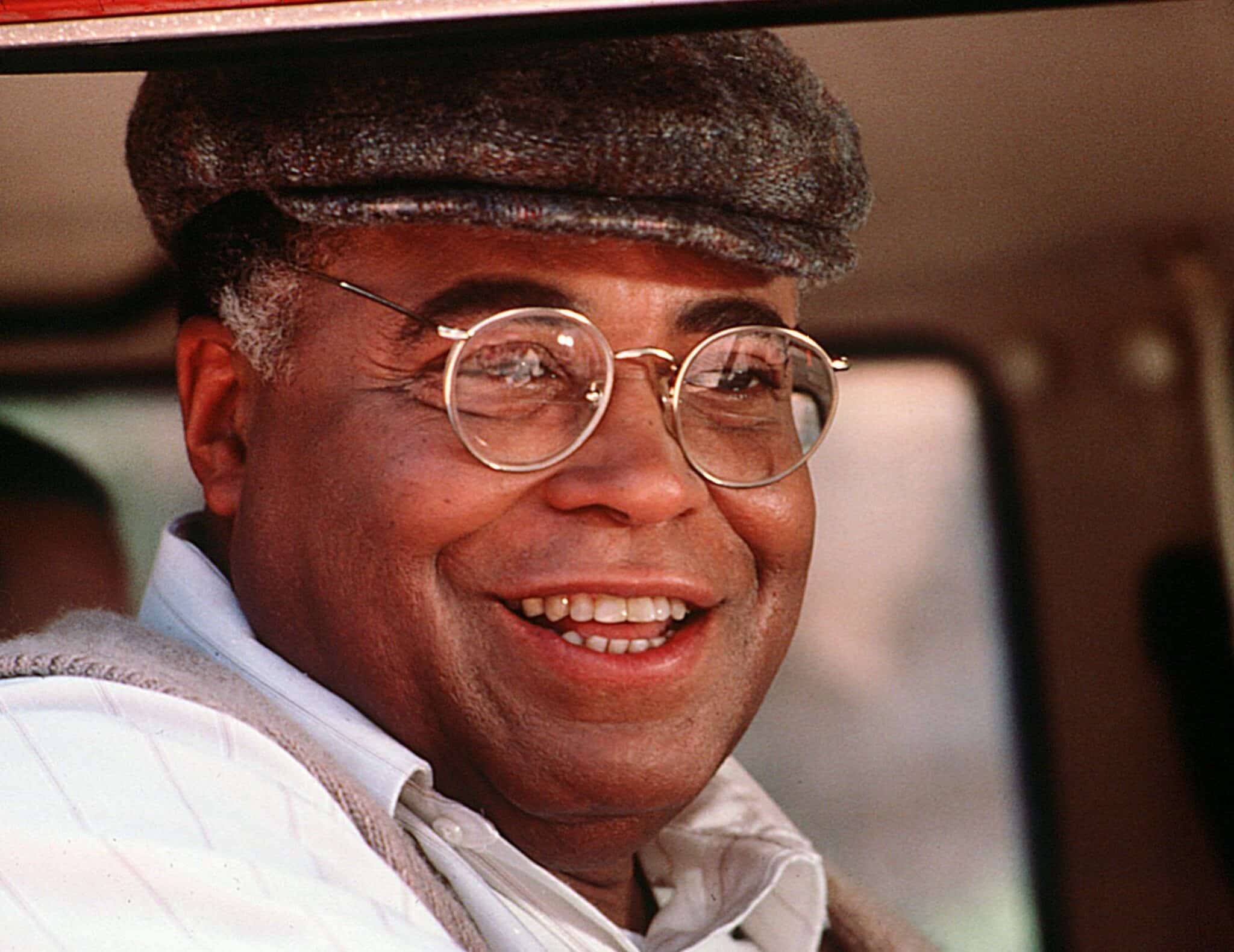
Field of Dreams sees Kevin Costner’s farmer Ray contact a reclusive author named Terence Mann (James Earl Jones). This is a change from the original novel Shoeless Joe, in which Ray meets a fictionalised version of an actual living author of the time: J.D. Salinger, writer of The Catcher in the Rye, and a notorious recluse in real life.
Given reclusive nature, Salinger had never met Kinsella. In a 2010 interview, W.P. Kinsella explained that “[Salinger’s] lawyers wrote my publisher’s lawyers saying he was outraged and offended to be portrayed in the novel and they would be very unhappy if it were transferred to other media.” For this reason, the fictitious Terence Mann was created for the movie.
23. Moonlight Graham was a real person

Moonlight Graham, played in Field of Dreams by Frank Whaley and Burt Lancaster, was based on a real baseball player of the same name. He was a medical student when he played his one and only major league game, playing right field for the New York Giants on 29th June 1905, and he played against the Brooklyn Superbas at Washington Park.
Graham is portrayed by two actors in Field of Dreams: Burt Lancaster plays the older Graham, and Frank Whaley plays Graham as a young man. However, there’s one minor difference between the real-life Graham and the movie Graham that only a baseball superfan might spot; he was actually left-handed.
22. Kevin Costner called the film his generation’s It’s A Wonderful Life

Initially, the producers of Field of Dreams did not pursue Kevin Costner for the lead role of Ray Kinsella. Costner had recently played a baseball player in Bull Durham, and the filmmakers didn’t think he’d want to make another film about the sport so soon. However, Costner loved the script, and reportedly felt the film could be “this generation’s It’s a Wonderful Life.”
There was another, more selfless reason that Costner was keen to be involved in Field of Dreams. Director Phil Alden Robinson’s previous film, 1987’s In The Mood, had flopped at the box office, threatening to harm his career. Believing his newfound star status would help the movie, Costner signed on in hopes of helping Robinson advance in the film industry.
21. Ray Liotta was cast because he had ‘a sense of danger’

Originally, director Phil Alden Robinson wanted to give the role of Shoeless Joe Jackson to an actor who was older than Kevin Costner, the idea being the character would act as a surrogate father figure to Costner’s Ray. However, the filmmaker had a change of heart when Ray Liotta auditioned for the role.
Although Liotta and Costner are the same age (born a month apart), Robinson felt Liotta had the “sense of danger” and ambiguity that was required for the role. Liotta’s dangerous quality would be capitalised on in a lot of his later films, most famously in 1990 gangster epic Goodfellas.
20. The identity of the actor who plays ‘the voice’ has never been revealed

One of the most celebrated aspects of Field of Dreams is the mysterious, seemingly disembodied voice in the corn field which speaks to Kevin Costner’s Ray throughout the movie. This voice is also the source of real-life mystery, as the filmmakers have never revealed whose voice it actually is.
Many people believe that the voice is Kevin Costner himself, or perhaps Ray Liotta, whilst others have claimed it’s actor Ed Harris. However, Phil Alden Robinson still isn’t giving anything away all these years later: the director told the LA Times in 2019, “we’ll let that remain a secret. It’s a great mystery, and I like that.”
19. Matt Damon and Ben Affleck both appear in the movie as extras

You might not notice them, but two superstars-in-waiting appear in Field of Dreams. Matt Damon and Ben Affleck are both in the movie, as uncredited extras in the Fenway Park scene. Still teens at the time, Damon and Affleck would achieve stardom and Oscars eight years later with 1997’s Good Will Hunting.
Once his star had substantially risen, Ben Affleck got to work with director Phil Alden Robinson again on 2002’s Tom Clancy adaptation The Sum of All Fears. Robinson was confused when Affleck told him it was nice to work with him again, until Affleck explained the connection.
18. It contains one of the most misquoted lines of all time
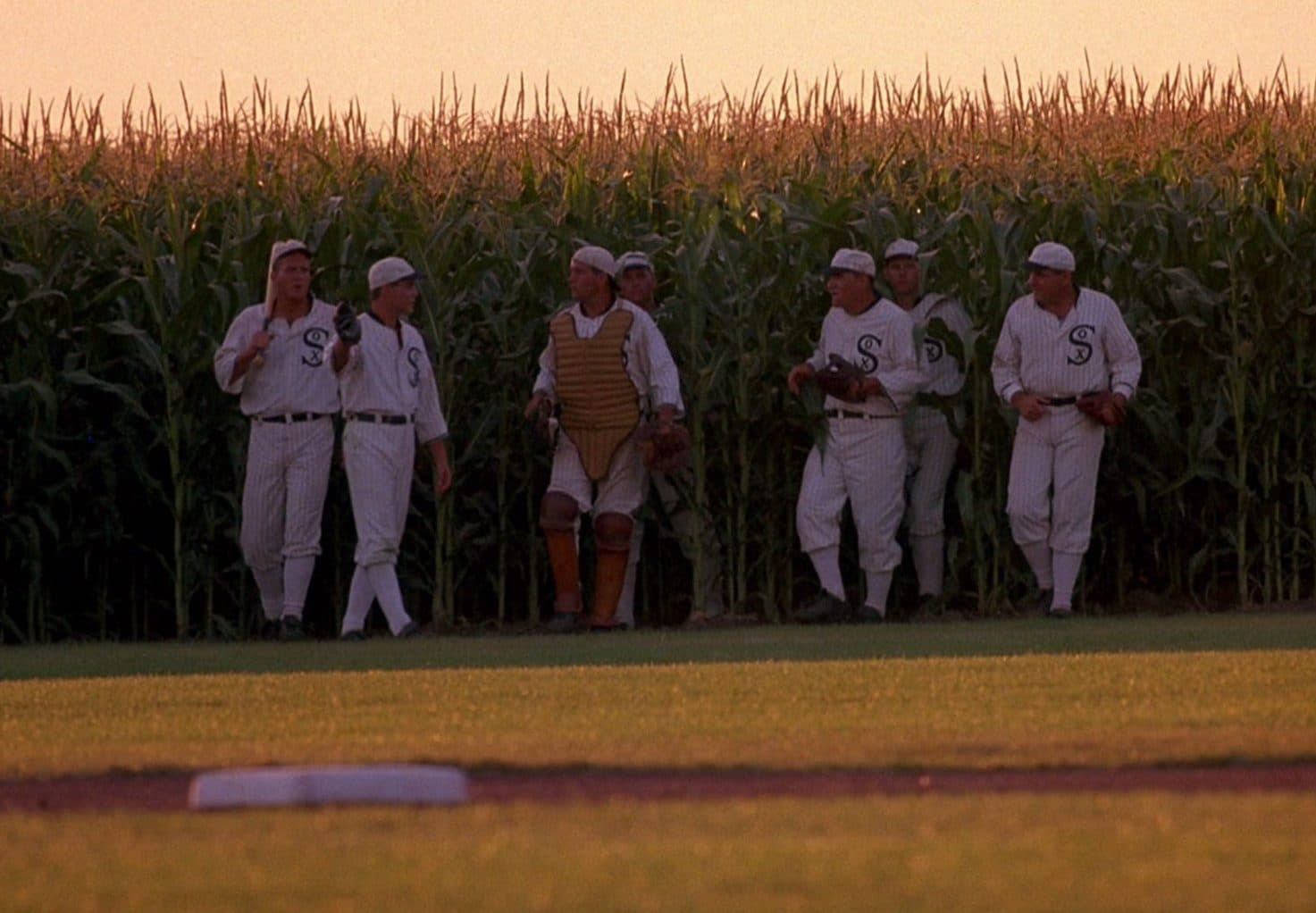
If we asked you to recite a classic line from Field of Dreams, we suspect many of you would say “if you build it, they will come.” If so, sorry to say you’d be incorrect, because the actual line spoken in the movie is “if you build it, he will come.”
Although the line became Field of Dreams’ signature catchphrase, it’s become legendary for how often people get it wrong. In fact, it was actually crowned one of the Daily Telegraph’s most misquoted film phrases in 2014, alongside the likes of The Empire Strikes Back line commonly misremembered as “Luke, I am your father.”
17. It was nominated for three Academy Awards including Best Picture
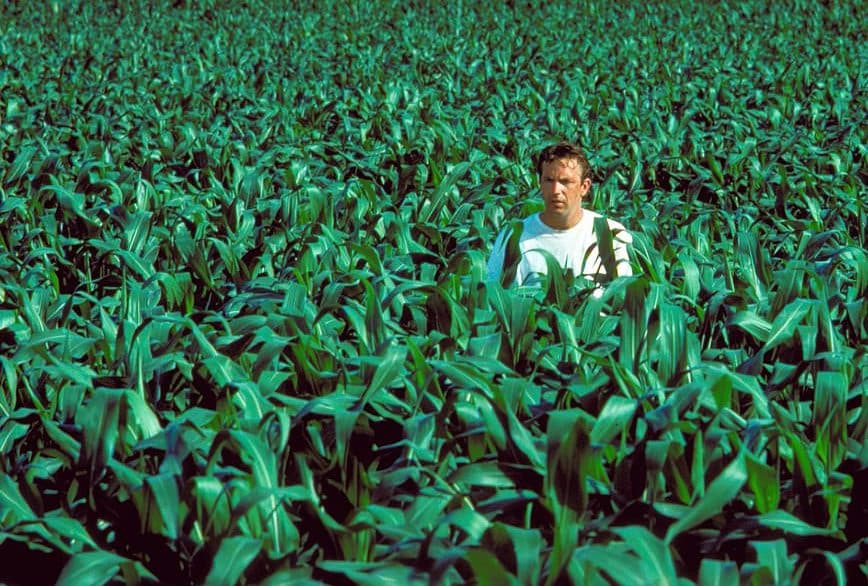
Having cost only $15 million to make, Field of Dreams proved to be a comfortable hit with box office takings of over $84 million. It also went down very well with critics, some of whom declared it an instant classic – so it’s not surprising that, come awards season, the Academy took notice.
Field of Dreams was nominated for three Academy Awards: Best Picture, Best Adapted Screenplay for Phil Alden Robinson, and Best Original Score for James Horner. Sadly, it failed to win any, missing out to Driving Miss Daisy in the first two categories and The Little Mermaid in the third.
16. Ray Liotta has never seen the movie

Field of Dreams became a must-see movie on release, yet to this day not everyone has seen the classic film. It may come as a surprise that one person who has never seen the movie is Ray Liotta, even though he plays one of the main parts in the film.
It’s not because Liotta has any qualms with the movie itself, but rather because his mother was seriously ill whilst he was filming it, and died not long afterwards. For this reason, Liotta has never wanted to watch the film, as it would take him back to that difficult time.
15. The baseball field was a tourist destination for many years

Field of Dreams sees a baseball field constructed in a remote corn field. This was indeed built for real in the film’s Iowa location, and remained in place afterwards. The field became a major a tourist destination for many years, with around 65,000 visitors every single year.
The field was built across two farms, although the majority of the field fell on the Lansing family’s property: they maintained the area afterwards and added a gift shop. In 2011, the farm containing the field was sold for an undisclosed amount, which was estimated to be around $5.5 million.
14. Real-life Field of Dreams baseball games are now an annual event
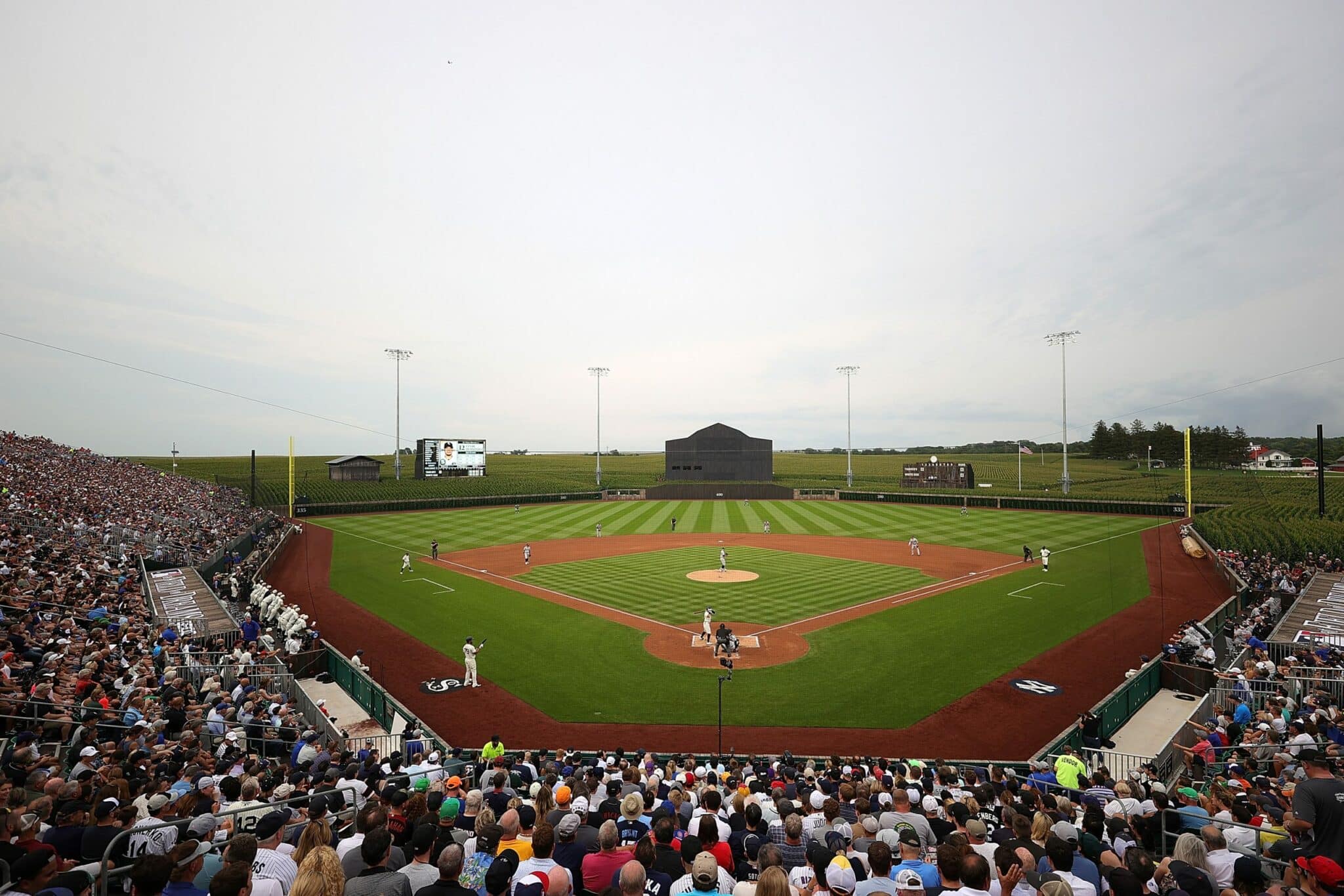
Not just one of the great sports movies, Field of Dreams also features one of the most iconic baseball fields of all time. However, some felt it was a bit of a waste that the real-life field has gone unused for decades, serving only as a tourist attraction. With this in mind, plans were set for a real Field of Dreams game.
The MLB made plans for the game between the Chicago White Sox and the New York Yankees to take place at the iconic location in August 2020. Sadly, this date proved to be slap-bang in the middle of the Covid-19 lockdown, which forced the event’s postponement. It eventually took place in August 2021 (with Kevin Costner in attendance), and games look set to continue every year.
13. Ray Liotta had never played baseball prior to signing up to the film
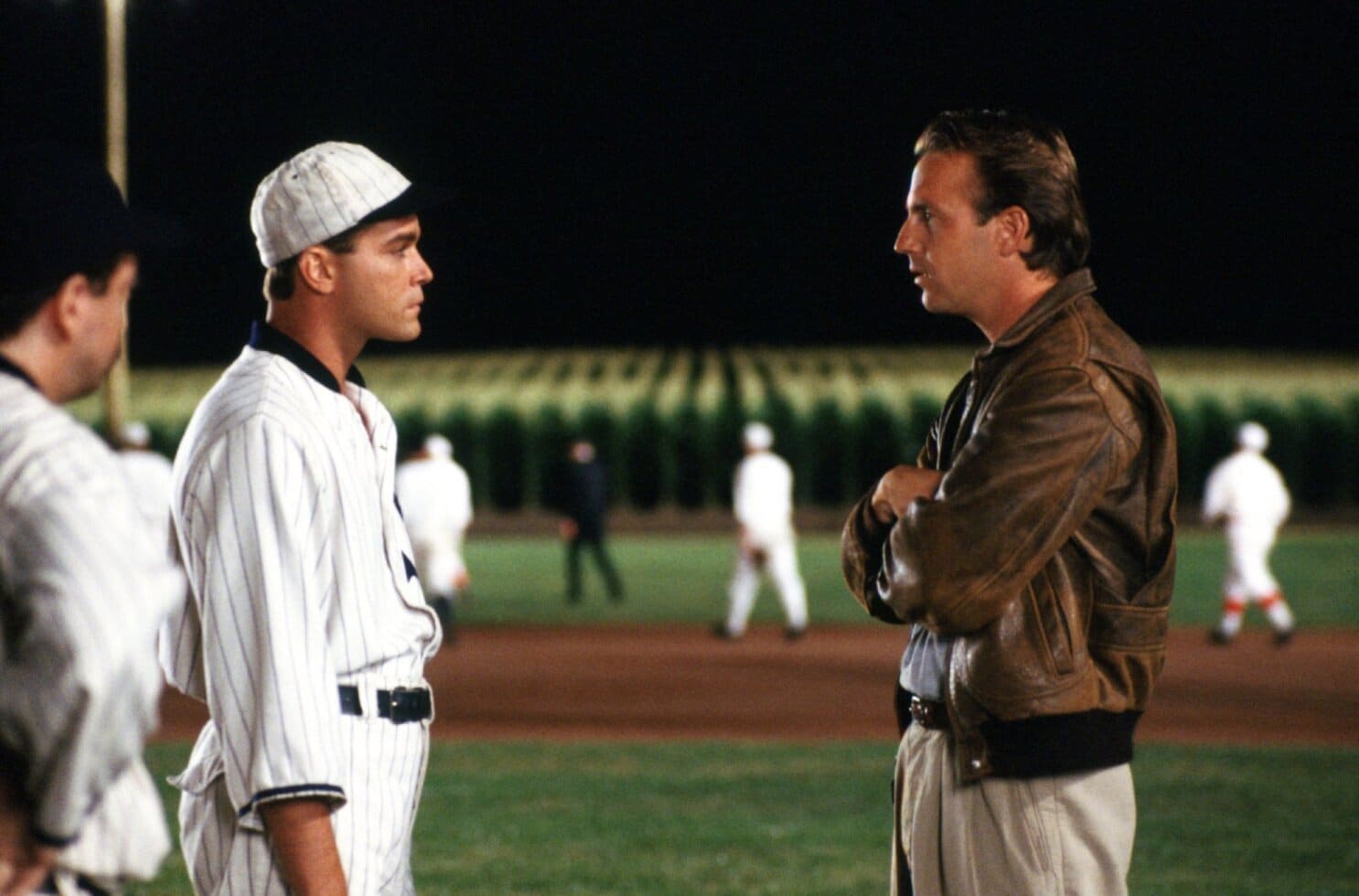
Despite his serious moves, you might be surprised to learn that Ray Liotta had never actually played baseball prior to filming Field of Dreams. The actor went through several weeks of extensive training with University of Southern California baseball coach, and former Brooklyn Dodger, Rod Dedeaux.
You can see in the film there are some discrepancies between the way Liotta’s character plays and how the real Joe Jackson played. One of these was that Liotta batted right-handed, whilst Jackson was actually left-handed in real life. Robinson allowed Liotta to bat with his right hand, but still wanted to make sure his actor’s moves were as convincing as possible.
12. The director had nightmares about fans of the book coming after him with knives
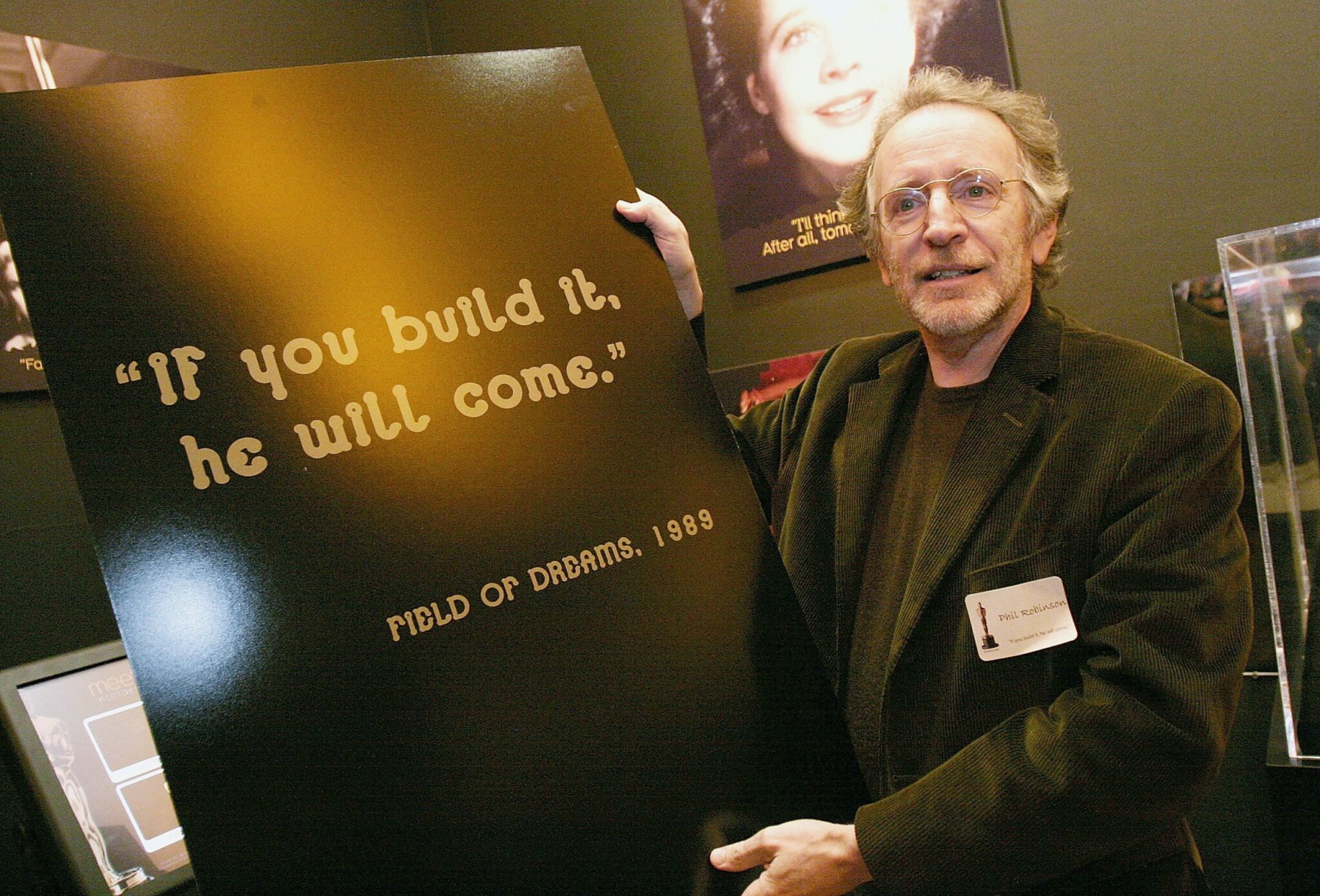
Writing and directing a film can be pretty strenuous work, and for some the pressure may get too intense. This was certainly the case for Phil Alden Robinson, who has admitted that the Field of Dreams shoot left him fraught with insecurity and self-doubt about his ability to tell the story effectively.
Robinson’s fears ran so deep that he began to have nightmares, envisioning angry fans of the book coming after him with knives. Luckily producer Lawrence Gordon saved the day, reassuring the writer-director that he was doing great work and needed to have faith in himself.
11. The field itself didn’t grow on time because of a drought

The filming of Field of Dreams naturally depended on there being an abundance of tall crops, but things unfortunately didn’t go exactly to plan. Shortly before shooting was set to begin on the film, a drought hit Iowa, leaving the crops grown for the film stunted.
With just three weeks to go, the production company spent $25,000 to truck in water from the Mississippi River in order to aid the plants’ growth. As a further backup, the production designer ordered 50,000 silk corn stalks from South Korea. Luckily, the water did the trick, and the silk stalks weren’t actually ever used.
10. The studio didn’t like the music at first

Prior to hiring a composer, writer-director Phil Alden Robinson decided to try his hand at creating a temporary soundtrack for Field of Dreams himself. However, his efforts were not appreciated by studio executives, who disliked this initial score. The hiring of experienced composer James Horner was subsequently met with relief.
The studio anticipated that Horner would give the film a full orchestral score similar to his earlier work on 1986’s An American Tail. However, Horner actually liked the subtlety and ghostly quality of Robinson’s temporary score, and so decided to aim for similar qualities when creating his own new score. He earned an Oscar nomination for his efforts.
9. The crew had to paint the grass green

As previously mentioned, Field of Dreams had the rotten luck of shooting during a drought. Thousands of pallets of green grass were ordered to produce the baseball field, and this required a lot of upkeep. Due to the haste in planting because of the filming schedule, the grass did not grow as expected and died before filming could take place.
In order to keep up appearances, the crew painted each individual blade of grass green. The sod on the field itself also struggled to maintain its lustrous green appearance, dying quickly in the drought. The groundskeeper suggested the crew paint this grass green as well, resulting in a flawless green field.
8. Robinson regretted not casting any African-American actors as baseball players

Since the film’s release, Robinson has said his biggest regret over the film was that no African-American actors were used in the roles of baseball players. However, it could be argued that to do so would have meant the film was historically inaccurate.
No African-American players played Major League baseball between 1884 and 1947. Of course, the film could have always explored the struggles facing African-American baseball players of the time, who never got a chance in the sport simply because of their race.
7. Jackson and Cobbs were good friends in real life

In the movie, Joe Jackson and Ty Cobbs did not get along, with Jackson referring to Cobbs thusly: ‘none of us could stand the son of a b***h when he was alive’. However, in real life, the pair were actually close friends, although they lost touch over the years as friends often do.
Later on in Jackson’s life, the ex-White Sox player ran a liquor store in South Carolina. One time, Cobbs stopped by the store to buy bourbon, and instantly recognised his old friend, saying ‘for God’s sake Joe, don’t you remember me?’ ‘Well, sure, I remember you, Ty,’ was Jackson’s sombre reply. ‘I just didn’t think anyone wanted to remember me anymore’.
6. The scene where Liotta hits a line-drive straight back at Kevin Costner actually happened
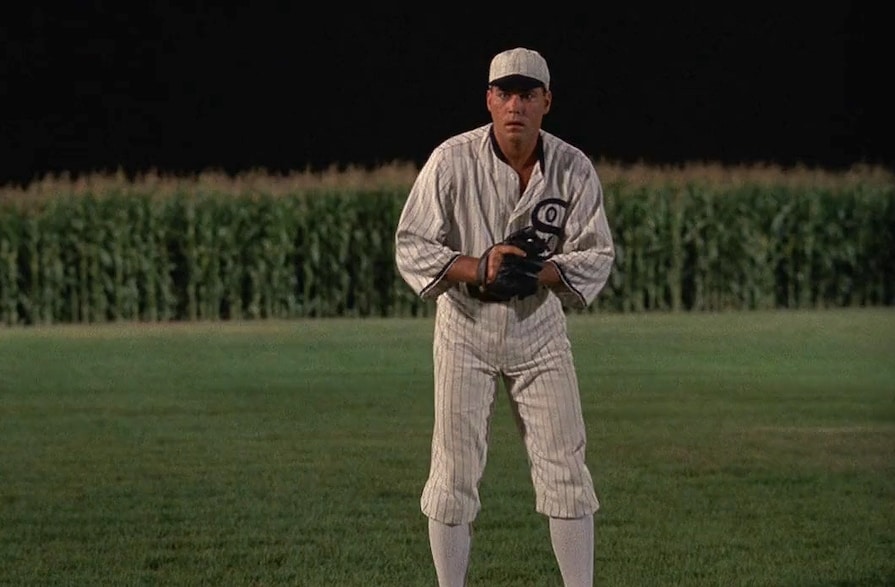
We’ve already mentioned how Liotta was not a natural sportsman, and how he went through rigorous training in order to perfect the sport prior to making the film. Eventually, the actor developed a good swing, and was able to convincingly portray a skilled baseball player.
One scene from the film is hard to forget: when Liotta hits a line-drive straight back at Kevin Costner. But this was not the result of CGI or a stuntman. In fact, the move was actually performed by the actor himself. Costner then fell on the mound, and although it was a surprise, he managed to stay in character.
5. The film caused the public to demand Joe Jackson be reinstated

Field of Dreams was released just eight months after another baseball movie, Eight Men Out, which portrayed the 1919 White Sox and World Series scandal. The success of both that film and Field of Dreams generated awareness of the team’s plight, resulting in many members of the public becoming sympathetic to the difficulties they endured.
Public sentiment soon began to grow in favour of seeing Joe Jackson’s lifetime ban from Major League Baseball being overturned. However, after a review it was deemed that there were insufficient grounds for the verdict to be reconsidered.
4. The final scene of cars lined up at the field was done for real
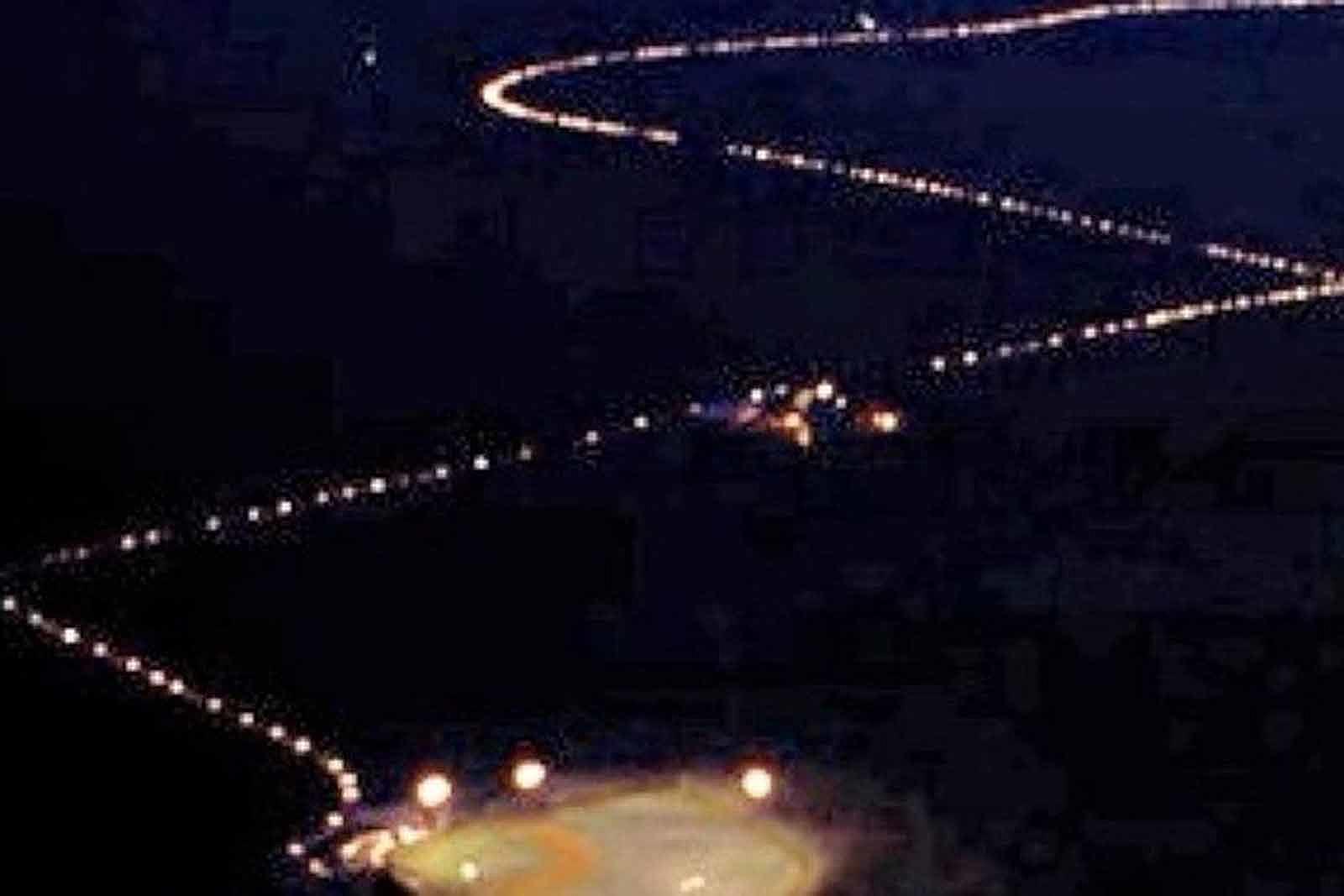
The final scene of the film is the one in which we see a seemingly endless horizon of cars, with only their lights visible in the darkness. While today this would probably be done with CGI, back in 1989 the most affordable approach was to create this shot practically, with a real line of cars going back miles.
Director Robinson broached the idea with the Iowa Chamber of Commerce, who readily agreed. The scene soon became a community event, with members of the public involved, acting as extras driving the cars. The film crew hid on the farm to avoid detection from the overhead cameras, and the town was blacked out to make the headlights appear more prominent.
3. In the book, Ray had a twin brother

Given that Kevin Costner was box office gold at the time, you might think that the Field of Dreams producers would be happy to give the star even more screen time than he already had. However, the filmmakers opted to delete a character from the original novel: Ray Kinsella’s twin brother.
Nor was this the only thing from W.P. Kinsella’s book that failed to make it to the screen. A number of other supporting characters were ditched, including the former owner of Ray’s farm, an ageing baseball fanatic who claimed to have played for the Chicago Cubs in his younger years.
2. James Stewart was the first choice for Burt Lancaster’s role
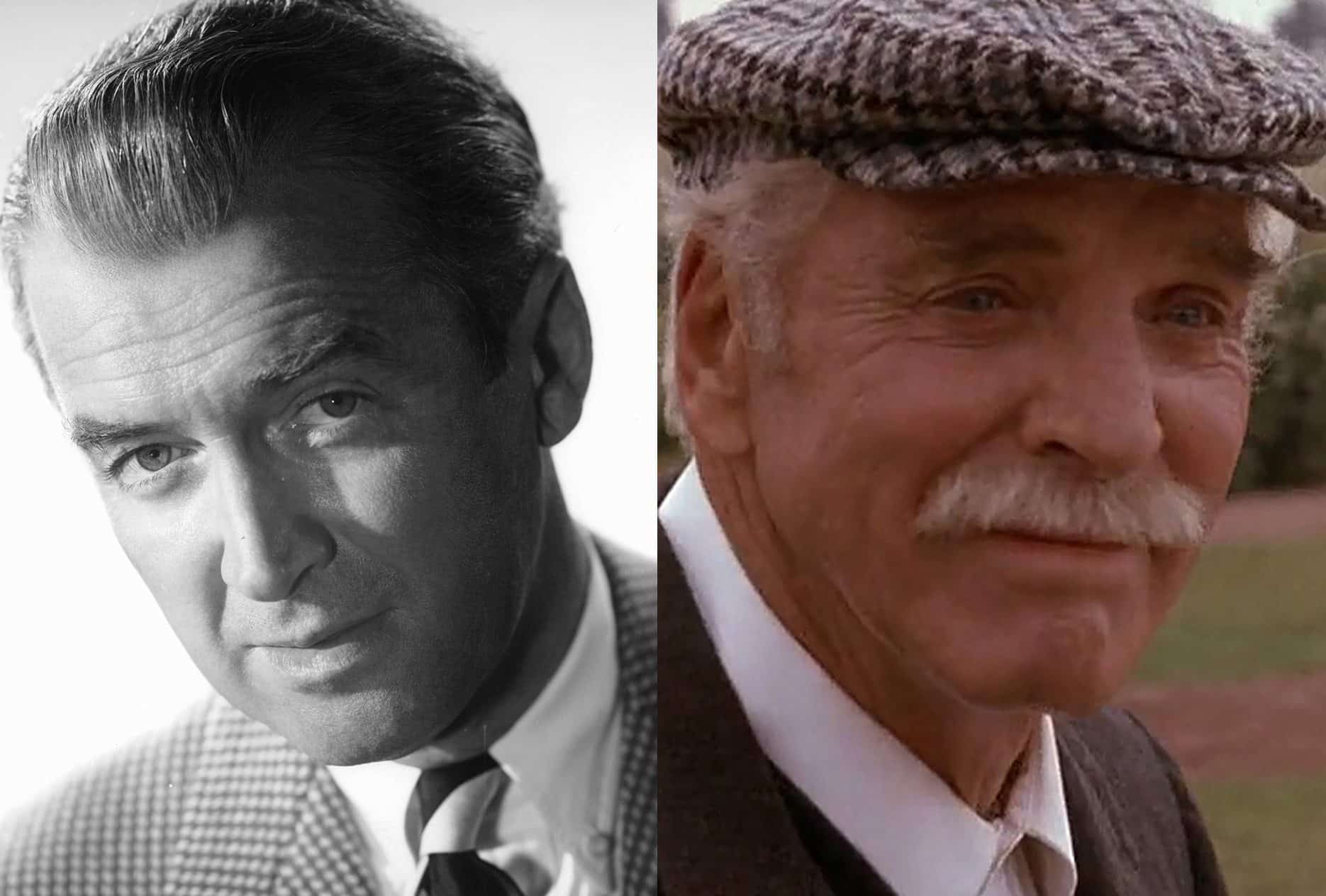
As Field of Dreams was pitched as the It’s a Wonderful Life of its era, it makes sense that the filmmakers would have liked a direct link to director Frank Capra’s classic. This perhaps explains why the first actor they pursued for the role of Moonlight Graham was none other than It’s a Wonderful Life leading man James Stewart.
Stewart passed; aged 80 at the time, the legendary actor hadn’t appeared on screen for almost a decade (his final credit would be a voice acting role in 1991’s An American Tail: Fievel Goes West). The offer then went out to Burt Lancaster, who almost turned the film down after not quite getting his head around the script, but was persuaded to accept the role by a baseball-loving friend.
1. A deleted scene would have shown Ray getting his hearing checked

Any stickler for common sense who watches Field of Dreams has doubtless asked why Costner’s Ray doesn’t question the weird voice he hears, and doesn’t seem to consider whether he has a problem. This was a question which had indeed occurred to the film’s director and screenwriter Phil Alden Robinson.
In Robinson’s first cut of the movie, there was a scene early on when Ray, having heard the whisper “if you build it, he will come” in the corn field, does what any sensible person would do and gets his hearing checked, only to be told he can hear perfectly. This scene was ultimately deemed unnecessary and hit the cutting room floor.

